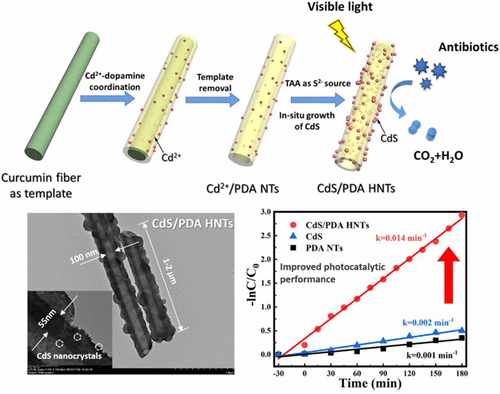当前位置:
X-MOL 学术
›
Ind. Eng. Chem. Res.
›
论文详情
Our official English website, www.x-mol.net, welcomes your
feedback! (Note: you will need to create a separate account there.)
Design of One-Dimensional Cadmium Sulfide/Polydopamine Heteronanotube Photocatalysts for Ultrafast Degradation of Antibiotics
Industrial & Engineering Chemistry Research ( IF 3.8 ) Pub Date : 2022-01-08 , DOI: 10.1021/acs.iecr.1c04104 Jingyu Lu 1 , Chuanjie Fang 1 , Guitu Wang 1 , Liping Zhu 1
Industrial & Engineering Chemistry Research ( IF 3.8 ) Pub Date : 2022-01-08 , DOI: 10.1021/acs.iecr.1c04104 Jingyu Lu 1 , Chuanjie Fang 1 , Guitu Wang 1 , Liping Zhu 1
Affiliation

|
The removal of antibiotics in environmental water is of significant importance due to their severe threats to human health and the ecosystem balance but remains as a major challenge. Visible-light photocatalytic degradation provides a desirable way to dispose of antibiotics by natural solar energy. Herein, cadmium sulfide-doped polydopamine (CdS/PDA) heteronanotubes (HNTs) featuring superior photocatalytic capability for ultrafast antibiotic degradation under visible light (14.2 times higher than traditional CdS) was developed via an in situ coordination polymerization strategy. The exceptional catalytic ability was attributed to multiple-level synergistic effects between PDA and CdS. PDA nanotubes (NTs) served as a scaffold for in situ growth of CdS nanocrystals, and the resulting CdS/PDA heterostructures exhibited strong visible-light-harvesting capability and a high transfer rate of photogenerated electron–hole pairs. Furthermore, the photocatalytic mechanism of the CdS/PDA HNTs toward model molecule tetracycline is disclosed in detail, and it is shown that superoxide radical anions (•O2–) and photogenerated holes (h+) play the key roles in the decomposition of tetracycline. Our findings demonstrate that the incorporation of PDA NTs as the scaffold is a feasible strategy to enhance the visible-light sensitivity of photocatalysts used in aqueous antibiotic degradation. This work provides new insights into the development of new functional nanocomposite catalysts with important engineering and environmental applications.
中文翻译:

超快降解抗生素的一维硫化镉/聚多巴胺异质纳米管光催化剂设计
由于抗生素对人类健康和生态系统平衡的严重威胁,去除环境水中的抗生素具有重要意义,但仍然是一项重大挑战。可见光光催化降解提供了一种通过天然太阳能处理抗生素的理想方法。在此,通过原位配位聚合策略开发了硫化镉掺杂的聚多巴胺 (CdS/PDA) 异质纳米管 (HNT),该异质纳米管 (HNT) 具有在可见光下超快抗生素降解的优异光催化能力(比传统 CdS 高 14.2 倍)。优异的催化能力归因于 PDA 和 CdS 之间的多层次协同效应。PDA 纳米管 (NTs) 作为 CdS 纳米晶体原位生长的支架,由此产生的CdS/PDA异质结构表现出很强的可见光捕获能力和光生电子-空穴对的高传输率。此外,详细披露了 CdS/PDA HNTs 对模型分子四环素的光催化机理,表明超氧自由基阴离子 (• O 2 – ) 和光生空穴(h + ) 在四环素的分解中起关键作用。我们的研究结果表明,将 PDA NTs 作为支架掺入是一种可行的策略,可以提高用于水性抗生素降解的光催化剂的可见光敏感性。这项工作为开发具有重要工程和环境应用的新型功能纳米复合催化剂提供了新的见解。
更新日期:2022-01-19
中文翻译:

超快降解抗生素的一维硫化镉/聚多巴胺异质纳米管光催化剂设计
由于抗生素对人类健康和生态系统平衡的严重威胁,去除环境水中的抗生素具有重要意义,但仍然是一项重大挑战。可见光光催化降解提供了一种通过天然太阳能处理抗生素的理想方法。在此,通过原位配位聚合策略开发了硫化镉掺杂的聚多巴胺 (CdS/PDA) 异质纳米管 (HNT),该异质纳米管 (HNT) 具有在可见光下超快抗生素降解的优异光催化能力(比传统 CdS 高 14.2 倍)。优异的催化能力归因于 PDA 和 CdS 之间的多层次协同效应。PDA 纳米管 (NTs) 作为 CdS 纳米晶体原位生长的支架,由此产生的CdS/PDA异质结构表现出很强的可见光捕获能力和光生电子-空穴对的高传输率。此外,详细披露了 CdS/PDA HNTs 对模型分子四环素的光催化机理,表明超氧自由基阴离子 (• O 2 – ) 和光生空穴(h + ) 在四环素的分解中起关键作用。我们的研究结果表明,将 PDA NTs 作为支架掺入是一种可行的策略,可以提高用于水性抗生素降解的光催化剂的可见光敏感性。这项工作为开发具有重要工程和环境应用的新型功能纳米复合催化剂提供了新的见解。











































 京公网安备 11010802027423号
京公网安备 11010802027423号